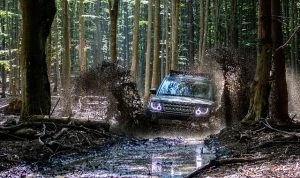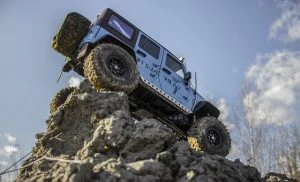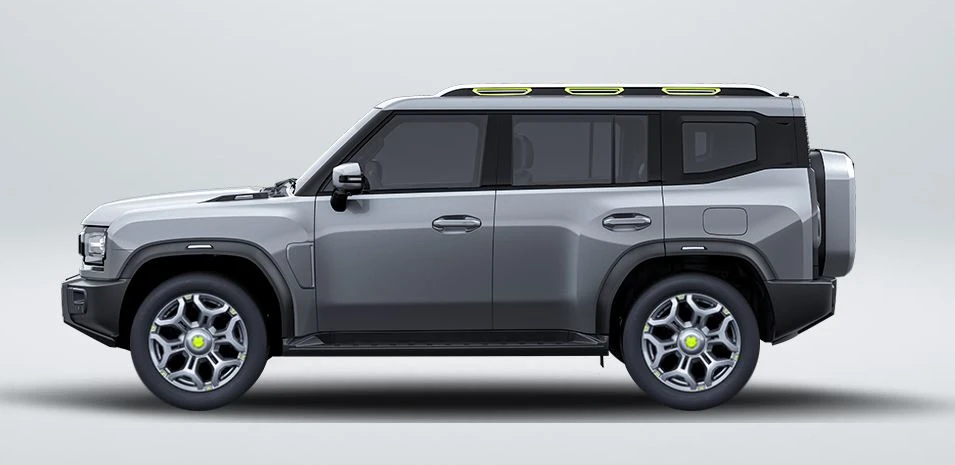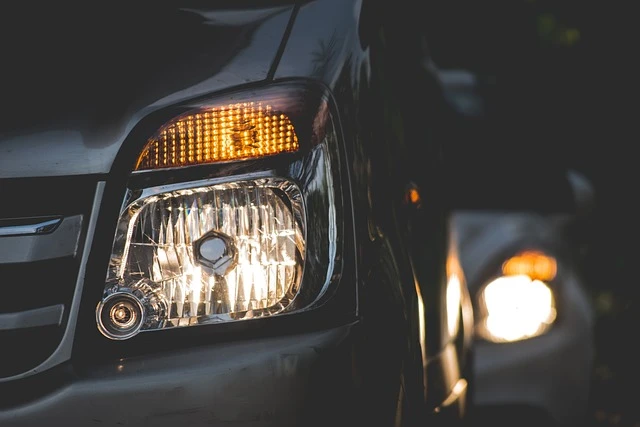Offroad Driving
4WD and AWD

Getting the best grip on the road or terrain is what will get you moving forwards from A to B in the shortest time. Ever since the invention of the first cars, two-wheel-drive has been the mainstay for delivering the engine’s power out to the wheels. At first, two-wheel drive was usually via the rear wheels, as it was much simpler to run a drive shaft from the engine at the front of the car back to the rear wheels to get grip from the rear wheels and to let the front wheels have the job of steering the vehicle.
In saying that, there is also history of 4WD being experimented with back as early as the late 1800s in combination with a traction engine, and, of course, in World War II, the 4WD Willys Jeep was a game-changer.

Once mechanical engineering and quality improved over time, the concept of having the engine over the front axle and the front wheels as the driving wheels as well as for steering the vehicle lowered production costs. A combination of rear-wheel-drive and front-wheel-drive cars were available as a matter of course right up to the 1970s and 1980s. Through the 1990s up until the present day, it was more common to see front-wheel-drive cars for everyday driving.
However, it was the 1980s that proved to be a very innovative period in automotive design and mechanical engineering. The greatest advancement in road-going cars was arguably the use of four-wheel-drive to establish greater levels of grip. As racing and supercars demanded faster cars, the need to control all that power (and actually make better use of it) was essential for winning, especially as there was an ever-increasing number of high-performance cars being pulled out of roadside hedges or being wrapped around power poles.
Enter Audi. Audi’s Quattro technology marked a significant moment in high-performance cars’ and supercars’ history. The Audi Quattro’s technology was essentially the dawn of the modern supercar’s 4WD system, and when Audi entered the World Rally Championship in 1981 with their Audi 80 Quattro car, they were unbeatable. The second-place car was over twenty minutes behind the race-winning Audi!
What is the difference between 4WD and AWD?
This is a good question to answer, because there are numerous new cars of all shapes and sizes available with AWD or 4WD. Generally speaking, four-wheel-drive (4WD) is the older off-road system that has the power split 50:50 front to rear. Add a diff-lock into a 4WD system, and these are off-road kings. Four-wheel-drive can be disengaged so that just two-wheel-drive (2WD) can be used on easier terrain, including for when you’ve finished your off-road adventure and you just want to head back home on the tarmac with 2WD only.
The basic principle of an all-wheel-drive (AWD) system is that it can deliver the optimum level of torque to each wheel individually, thus giving the best possible drive and traction. AWD systems tend to be permanently engaged, but with the power split front to rear, along with individual wheels being variable according to what each wheel is sensing and therefore demanding at the time. AWD systems are more complex in that they use sensors which send precise information and values of each wheels’ speed, torque, wheel slip/spin, brake pressure, and steering input to the AWD’s central control system. The control system then adjusts the torque supplied to each wheel.
Land Rovers and many other new serious off-road vehicles use AWD systems with various diff-locking abilities, which also make them real off-road kings. Four-wheel-drive systems are simpler in nature and are thus simpler and cheaper to fix than more complex AWDs. That said, many manufactures like Subaru know how to make solid, dependable AWD systems for their cars and SUVs that are mainly aimed at everyday on-road use and trips up to the ski fields, but with the credentials for performing well even in some fairly serious off-road terrain.
If you live in a part of the world where gravel roads and rainy seasons collide, then an AWD vehicle with decent ground clearance should be parked up your driveway. If your day includes a trek out to the building site, feeding out to stock, or traversing any serious off-road terrain, then a heavy-duty 4WD or AWD vehicle will be your companion. The good news is there are plenty of these sorts of vehicles about, many of which can be bought new at a good price via Private Fleet.

Introducing The Jetour

I’ve always loved the exterior of the Land Rover Defender, whether old or new. Its boxy shape and rugged appearance are perfectly crafted for off-roading. The short front and rear overhangs are just perfect for clearing steep entry and exit points on a slope. Of course, there is also the legendary Defender’s 4WD powertrain that is the rock of what makes this an immensely capable 4×4 off-road machine. However, there is another vehicle coming to Australia with that same chunky, boxy shape and talented off-road skills. This new machine comes to us from China and will be available to buy down under in 2025. Let’s take a closer look, and by this, I mean you’ll need to look really closely to make sure it is a Jetour and not a Defender. A big hint is to read the brand name that runs across the front of the bonnet!
It is said that we all have a double of ourselves somewhere in the world (I know I do). This double basically looks like us. Land Rover Defender’s double or doppelganger (German for “double walker”) would surely have to be the new Jetour. The Jetour is a vehicle that was designed to be a luxury crossover brand in 2018 and is the creation born from the Chery Holding Group, often known simply as Chery. Chery is an automotive group currently based in the eastern Chinese city of Wuhu. Born in 1997, Chery has grown and developed in a diversified manner with automobiles as its primary business. Over time, Chery have created automobiles, gotten involved in automotive parts, finance, property and modern services. Chery now has over 300 member-enterprises; these include Chery Automobile, Chery Commercial Vehicle, Chery Jaguar Land Rover, Chery Finance and Chery Technology.
The Jetour T2 large off-roader does look really good in the metal, with its square boxy body shape, bold wheel arches and big rubber, high ground clearance, a swinging tailgate with a spare tyre on the outside, big solid bumpers, and an interior that won’t mind getting dirty from an adventure Outback.
Similar again to how Land Rover has designed its latest Defender, the 2024 Jetour T2 is built around a monocoque body, which is a design that offers loads of structural rigidity and stiffness for tackling the rigours of serious off-roading. The monocoque body is the perfect solid foundation for the Jetour T2 4×4’s advanced all-independent chassis. An independent suspension means that all four wheels can drop and ride over large obstacles individually and independently of what the other three wheels are doing at the same time. This enhances the ability to obtain maximum traction at each wheel, perfect for progressing through tricky and slippery terrain.
The new Jetour will come with the option of either a 1.5-litre or a 2.0-litre turbo petrol engine to power the 4×4, and the engine’s power is sent through a seven-speed dual-clutch automatic transmission for ensuring optimum engine torque is harnessed at all times. Having a ground clearance rated at 220 mm, and with the engine’s drive sent to all four wheels via the full-time 4×4 system, this is an exciting new off-road SUV for the Adventurer needing a new vehicle to get them to a remote location.
We’re looking forward to it, and be sure that we’ll review it fully when it makes it over here.
Throwing Some Light On The Subject Of Lights

Once upon a time, cars were fitted with carbide lights, practically identical to the sort old-school miners wore on their helmets. These had to be lit with a match, a cigarette lighter or, if you were lucky, a built in flint and steel striking mechanism. They weren’t in the business long, as electric lights were put on cars in around 1912 or so. We’ve certainly come a long way since then and we’ve got more than a pair of carbide lanterns. If you’ve thought about adding some aftermarket tweaks to your vehicle, lights are some of the first things that we can try adjusting or adding. However, it pays to know what you’re talking about, so let’s look at what’s what.
Headlights
These are your bread and butter basics. They are there to stop you running into things at night and see where the road goes. They probably don’t need any introduction, but we’ll touch on them briefly. They are at the front and they’re white. The idea is that they illuminate as far as possible when on full beam and are dipped when another vehicle comes the other way. We know how they work. However, please remember the following: (1) you turn them on when there’s not enough light to see a person in dark clothing 100 m away, i.e., when the sun is below the horizon; (2) don’t play Headlight Chicken where you see who dips first.
Auxiliary Lights
Auxiliary lights are the ones that aren’t the bog-standard headlights, indicators and taillights. Not all cars have them when they roll off the factory floor, but many of them can be fitted as after-market mods. They’re particularly popular on off-roading vehicles, and for good reason. If you’re going out into the middle of nowhere, you really need to see all the rocks, holes and wandering animals, so more lights are needed (doubly so if you go spotlighting for rabbits).
Let’s have a look at the different sorts and what they’re for.
Fog Lights
Fog lights are for moments when something’s blurring visibility rather than for when it’s dark. Fog lights tend to keep the beam of light low so that it lights up the road but doesn’t hit the fog or dust and make the problem worse. If the light hits the dust or fog, then it will be scattered and make visibility worse.
Fog lights can be either amber or white. They have to turn off and on separately from the headlights. You’re not supposed to use them at night time as auxiliary lights, and you’re not supposed to use them at all unless the conditions warrant it.
Daytime Running Lights
Daytime running lights, commonly abbreviated DRLs, are lights fitted to the front of a vehicle that aren’t there so the driver can see but so that they can be seen. They’re supposed to be wired so that they go off when the headlights go on (unless you’re flashing your headlights temporarily to alert another driver about something, like the fact that their boot is open).
In some places, DRLs are required by law on all new vehicles. I’m not sure whether I agree with this or not. Certainly, out on the open road on an overcast day, DRLs have alerted me to a grey car on a grey road under a grey sky that would otherwise be hard to pick. However, around town, when every vehicle has DRLs and everything around them seems to have lights or at least be reflective, DRLs fall victim to the “if everyone’s special, then nobody’s special” syndrome and they don’t act as a warning of the presence of another vehicle more than the big metal box on wheels they’re mounted on.
Additional Driving Lights
Additional driving lights are like your headlights but they’re in addition to your headlights. Instead of having two headlights (or, in quite a few cases, four), you can have four (or six). Because they’re not as sophisticated as your main headlights, they only come on when the headlights are on high beam and should go off when you dip the headlights. This is for the simple reason that these auxiliary lights can’t dip, so if they stayed on, they’d dazzle the oncoming driver. They are sometimes called spotlights or spots.
The exact laws about where you can install additional driving lights vary slightly from state to state and they seem to be updated all the time. The general idea is that you are supposed to install them symmetrically about the centre of the vehicle’s bumper and that you can’t put them somewhere that could be dangerous, either because they protrude like horns or because they block the driver’s vision or dazzle the driver. In general, if you put lights on the front of your 4×4 so that they are surrounded by the bull bars rather than sticking out from them in front or on the side, you’re all good.
Light bars are a subcategory of additional driving light. Light bars are made up of a strip of LED lights, all acting in tandem. Legally, they are considered to be one light if they all turn on and off at the same time; if different bits turn on and off at different times, each bit of the light bar is considered to be a separate light. As lights must be mounted symmetrically around the front of the car, you can have a single light bar in the front and centre of your vehicle.
The ultimate in auxiliary lights or spotlights is the roof-mounted rack of lights that you’ll see on some 4x4s and are popular with hunters going out after dark. These are not legal in all states of Australia under all circumstances, with some states allowing them for use by hunting or when the vehicle is stationary or when the vehicle is off-road. These rules also seem to be updated every time you turn around, so check what applies to you before going to the effort and expense of buying or fitting them.
Puddle lights
The sole purpose of a puddle light is to cast a patch of light on the ground beside the door – very useful if you don’t want to put your best shoes into a puddle or a pile of dog poo. Some of the cars that have them as standard have a clever design so as well as throwing a patch of light onto the ground, it can also throw down a logo as a shadow – or even a patch of light thanks to LED tech. Aftermarket puddle lights are also out there, some of which have some quite quirky styles.